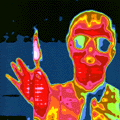How can we "see" using the Infrared?
Since the primary source of infrared
radiation is heat or thermal radiation, any
object which has a temperature radiates in
the infrared. Even objects that we think of
as being very cold, such as an ice cube,
emit infrared. When an object is not quite
hot enough to radiate visible light, it will
emit most of its energy in the infrared. For
example, hot charcoal may not give off light
but it does emit infrared radiation which we
feel as heat. The warmer the object, the
more infrared radiation it emits.
|
Humans, at normal body temperature,
radiate most strongly in the
infrared at a wavelength of about 10
microns. (A micron is the term
commonly used in astronomy for a
micrometer or one millionth of a
meter.) This image ( which is
courtesy of the Infrared Processing
and Analysis Center at CalTech),
shows a man holding up a lighted
match! Which parts of this image do
you think have the warmest
temperature? How does the
temperature of this man's glasses
compare to the temperature of his
hand? |


|
 
|
To
make infrared pictures like the one
above, we can use special cameras
and film that detect differences in
temperature, and then assign
different brightnesses or false
colors to them. This provides a
picture that our eyes can interpret.
The image at the left (courtesy
of SE-IR Corporation, Goleta, CA)
shows a cat in the infrared. The
orange areas are the warmest and the
white-blue areas are the coldest.
This image gives us a different view
of a familiar animal as well as
information that we could not get
from a visible light picture.
|
Humans may not be able to
see infrared light, but did you know that
snakes in the pit viper family, like
rattlesnakes, have sensory "pits", which are
used to image infrared light? This allows
the snake to detect warm blooded animals,
even in dark burrows! Snakes with 2 sensory
pits are even thought to have some depth
perception in the infrared! (Thanks to
NASA's Infrared Processing and Analysis
Center for help with the text in this
section.)
Many things besides people and animals
emit infrared light - the Earth, the Sun,
and far away things like stars and galaxies
do also! For a view from Earth orbit,
whether we are looking out into space or
down at Earth, we can use instruments on
board satellites.